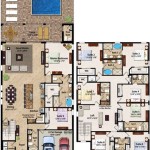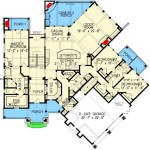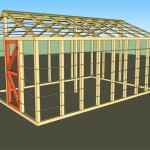Greek Revival Style House Plans are architectural blueprints designed to guide the construction of houses that adhere to the principles of the Greek Revival style, a popular architectural movement that flourished in the United States from the 1820s to the 1860s. Inspired by the classical architecture of ancient Greece, these plans feature symmetrical facades, columns, pediments, and other elements that evoke the grandeur and aesthetics of temples and other civic buildings from that era.
The revival of the Greek architectural style in the 19th century was influenced by a growing fascination with ancient Greek culture, fueled by the archaeological discoveries in Greece at the time. Architects and designers sought to recreate the elegance and sophistication of Greek architecture in the homes they designed, resulting in the creation of houses that exuded an air of authority and refinement.
In the following sections, we will explore the key characteristics, advantages, and considerations associated with Greek Revival Style House Plans, providing insights into their enduring appeal and adaptability in modern home design.
Greek Revival Style House Plans are characterized by several key features that define their distinctive aesthetic:
- Symmetrical facades
- Porticos with columns
- Pediments over windows and doors
- Classical moldings and trim
- Gabled roofs
- Palladian windows
- Arched openings
- Fanlights
- Sidelights
- Juliet balconies
These elements combine to create a sense of grandeur, proportion, and timeless elegance.
Symmetrical facades
Symmetrical facades are a defining characteristic of Greek Revival Style House Plans. Symmetry creates a sense of balance and harmony, and it is often used in architecture to convey a sense of grandeur and importance.
- Central focus: Symmetrical facades typically have a central focus, such as a front door or a portico, that is flanked by matching elements on either side. This creates a sense of visual hierarchy and draws the eye to the center of the house.
- Balance and proportion: The symmetrical arrangement of elements on the facade creates a sense of balance and proportion. This is achieved by using the same or similar elements on both sides of the central focus, and by ensuring that the elements are arranged in a harmonious way.
- Order and regularity: Symmetry implies order and regularity, which are qualities that are often associated with Greek Revival architecture. The symmetrical arrangement of elements on the facade creates a sense of order and predictability, which can be calming and reassuring to the viewer.
- Timeless appeal: Symmetrical facades have a timeless appeal that transcends changing architectural styles. They are often seen as being both elegant and sophisticated, and they can add a touch of grandeur to any home.
Overall, symmetrical facades are an important part of Greek Revival Style House Plans. They create a sense of balance, harmony, and grandeur, and they contribute to the timeless appeal of this architectural style.
Porticos with columns
Porticos with columns are another key feature of Greek Revival Style House Plans. Porticos are covered entrances that are supported by columns. They provide shelter from the elements and can also add a touch of grandeur to a home.
- Classical inspiration: The use of porticos with columns in Greek Revival Style House Plans is inspired by the classical architecture of ancient Greece. Greek temples and other public buildings often featured porticos with columns, which served as a way to mark the entrance to the building and to provide shelter from the sun and rain.
- Focal point: Porticos with columns can serve as a focal point for the front of a house. They draw the eye to the entrance and create a sense of importance. Columns can be used to create a variety of different looks, from simple and elegant to grand and imposing.
- Functional and decorative: Porticos with columns are not only decorative, but they can also be functional. They can provide shelter from the elements, and they can also be used to create a sense of privacy. Porticos can be enclosed with screens or glass to create a three-season room that can be used for relaxing, entertaining, or dining.
- Timeless appeal: Porticos with columns have a timeless appeal that transcends changing architectural styles. They are often seen as being both elegant and sophisticated, and they can add a touch of grandeur to any home.
Overall, porticos with columns are an important part of Greek Revival Style House Plans. They create a sense of grandeur, provide shelter from the elements, and can serve as a focal point for the front of a house. Porticos with columns are a timeless architectural element that can add beauty and value to any home.
Pediments over windows and doors
Pediments are triangular gables that are often used to crown windows and doors in Greek Revival Style House Plans. Pediments add a touch of grandeur and formality to a home, and they can also help to draw the eye to important architectural features.
Pediments are typically made of wood or stone, and they can be either plain or ornamented. Plain pediments have a simple triangular shape, while ornamented pediments may feature dentils, moldings, or other decorative elements. The size and shape of the pediment will vary depending on the size and style of the window or door.
Pediments can be used to create a variety of different looks, from simple and elegant to grand and imposing. They can be used to highlight important architectural features, such as the front door or a Palladian window. Pediments can also be used to add a touch of visual interest to a plain wall.
Overall, pediments over windows and doors are an important part of Greek Revival Style House Plans. They add a touch of grandeur and formality to a home, and they can also help to draw the eye to important architectural features. Pediments are a versatile architectural element that can be used to create a variety of different looks.
Classical moldings and trim
Classical moldings and trim are an important part of Greek Revival Style House Plans. Moldings are decorative elements that are used to add visual interest and detail to a home’s exterior. Trim is used to finish the edges of windows, doors, and other openings. Both moldings and trim can be made from a variety of materials, including wood, stone, and plaster.
The use of classical moldings and trim in Greek Revival Style House Plans is inspired by the classical architecture of ancient Greece. Greek temples and other public buildings were often adorned with elaborate moldings and trim, which served to enhance the beauty and grandeur of the buildings.
In Greek Revival Style House Plans, moldings and trim are used to create a variety of different effects. Moldings can be used to add visual interest to a plain wall, to highlight important architectural features, or to create a sense of grandeur. Trim can be used to finish the edges of windows and doors, to create a more polished look, or to add a touch of detail to a home’s exterior.
Overall, classical moldings and trim are an important part of Greek Revival Style House Plans. They add a touch of elegance and sophistication to a home, and they can help to create a sense of grandeur and importance. Moldings and trim are a versatile architectural element that can be used to create a variety of different looks, from simple and understated to elaborate and ornate.
Gabled roofs
Gabled roofs are a defining feature of Greek Revival Style House Plans. A gabled roof is a roof with two sloping sides that meet at a ridge. The triangular shape formed by the two sloping sides is called a gable.
Gabled roofs are one of the oldest and most common types of roofs in the world. They are simple to construct and provide good protection from the elements. Gabled roofs are also visually appealing, and they can add a touch of charm and character to a home.
In Greek Revival Style House Plans, gabled roofs are often used to create a sense of grandeur and importance. The steep slope of the roof and the triangular shape of the gable give the house a distinctive and imposing appearance. Gabled roofs can also be used to add visual interest to a home, and they can help to draw the eye to important architectural features, such as the front door or a Palladian window.
Overall, gabled roofs are an important part of Greek Revival Style House Plans. They add a touch of grandeur and charm to a home, and they can help to create a sense of importance and distinction. Gabled roofs are a versatile architectural element that can be used to create a variety of different looks, from simple and understated to elaborate and ornate.
In addition to their aesthetic appeal, gabled roofs also offer several practical advantages. The steep slope of the roof helps to shed water and snow quickly and efficiently. This can help to prevent leaks and damage to the roof and the rest of the house. Gabled roofs also provide good ventilation, which can help to keep the house cool in the summer and warm in the winter.
Palladian windows
Palladian windows are large, three-part windows that are often used in Greek Revival Style House Plans. They are named after the Italian architect Andrea Palladio, who popularized the use of this type of window in the 16th century.
- Multiple panes: Palladian windows are made up of three panes, with the central pane being taller and wider than the two flanking panes. This creates a distinctive and elegant look that is often associated with Greek Revival architecture.
- Arched tops: The central pane of a Palladian window is typically topped by a semicircular arch, while the two flanking panes are topped by smaller, segmental arches. This combination of arches creates a visually appealing and balanced composition.
- Abundant natural light: Palladian windows allow for an abundance of natural light to enter a room. This can help to create a bright and airy space that is both inviting and comfortable.
- Focal point: Palladian windows can serve as a focal point for a room. Their large size and distinctive shape draw the eye and create a sense of grandeur and importance.
Overall, Palladian windows are an important part of Greek Revival Style House Plans. They add a touch of elegance and sophistication to a home, and they can help to create a sense of grandeur and importance. Palladian windows are a versatile architectural element that can be used to create a variety of different looks, from simple and understated to elaborate and ornate.
Arched openings
Arched openings are a common feature in Greek Revival Style House Plans. Arches can be used to create a variety of different openings, including doorways, windows, and porticos. They add a touch of elegance and sophistication to a home, and they can also help to create a sense of grandeur and importance.
- Rounded shape: Arches have a rounded shape that creates a visually appealing and distinctive look. They can be used to add a touch of softness and femininity to a home, or they can be used to create a more formal and imposing look.
- Variety of styles: Arches can be made in a variety of different styles, from simple and understated to elaborate and ornate. The style of the arch will depend on the overall style of the house and the desired effect.
- Structural strength: Arches are structurally strong and can be used to create large openings without the need for additional support. This makes them ideal for use in doorways, windows, and porticos.
- Timeless appeal: Arches have a timeless appeal that transcends changing architectural styles. They have been used in architecture for centuries, and they continue to be popular today. Arches can add a touch of elegance and sophistication to any home, regardless of its architectural style.
Overall, arched openings are an important part of Greek Revival Style House Plans. They add a touch of elegance and sophistication to a home, and they can also help to create a sense of grandeur and importance. Arches are a versatile architectural element that can be used to create a variety of different looks, from simple and understated to elaborate and ornate.
Fanlights
Fanlights are decorative windows that are placed above doors or windows. They are typically semi-circular in shape and are filled with delicate tracery or stained glass. Fanlights add a touch of elegance and sophistication to a home, and they can also help to create a sense of grandeur and importance.
Fanlights were first used in the 18th century in England. They quickly became popular in the United States, and they were often used in Greek Revival Style House Plans. Fanlights are particularly well-suited to Greek Revival style homes, as they add a touch of classical elegance to the facade.
Fanlights can be made from a variety of materials, including wood, stone, and glass. The most common type of fanlight is made from wood and features a delicate tracery design. Stained glass fanlights are also popular, and they can add a touch of color and beauty to a home.
Fanlights are a versatile architectural element that can be used to create a variety of different looks. They can be used to add a touch of elegance to a simple doorway, or they can be used to create a more grand and imposing entrance. Fanlights are also a popular choice for windows, and they can add a touch of charm and character to any room.
Overall, fanlights are an important part of Greek Revival Style House Plans. They add a touch of elegance and sophistication to a home, and they can also help to create a sense of grandeur and importance. Fanlights are a versatile architectural element that can be used to create a variety of different looks, from simple and understated to elaborate and ornate.
Sidelights
Sidelights are windows that are placed on either side of a door. They are typically narrow and rectangular in shape, and they are often filled with clear or frosted glass. Sidelights allow for natural light to enter a home, and they can also help to create a more open and inviting entrance.
Sidelights were first used in the 18th century in England. They quickly became popular in the United States, and they were often used in Greek Revival Style House Plans. Sidelights are particularly well-suited to Greek Revival style homes, as they add a touch of classical elegance to the facade.
Sidelights can be made from a variety of materials, including wood, stone, and glass. The most common type of sidelight is made from wood and features a simple rectangular design. Sidelights can also be made with decorative elements, such as moldings or trim. Frosted glass is often used in sidelights to provide privacy while still allowing for natural light to enter the home.
Sidelights are a versatile architectural element that can be used to create a variety of different looks. They can be used to add a touch of elegance to a simple doorway, or they can be used to create a more grand and imposing entrance. Sidelights are also a popular choice for windows, and they can add a touch of charm and character to any room.
Overall, sidelights are an important part of Greek Revival Style House Plans. They add a touch of elegance and sophistication to a home, and they can also help to create a sense of grandeur and importance. Sidelights are a versatile architectural element that can be used to create a variety of different looks, from simple and understated to elaborate and ornate.
Juliet balconies
Juliet balconies are small, decorative balconies that are typically placed outside of a window. They are often made of wrought iron or cast iron, and they feature a delicate and ornate design. Juliet balconies add a touch of elegance and sophistication to a home, and they can also help to create a sense of romance and whimsy.
- Small and decorative: Juliet balconies are small and decorative, and they are typically only large enough for one or two people to stand on. They are often used to add a touch of visual interest to a home’s exterior, and they can also be used to provide a small outdoor space for relaxation or enjoyment.
- Wrought iron or cast iron: Juliet balconies are typically made of wrought iron or cast iron. Wrought iron is a strong and durable material that is relatively easy to work with. Cast iron is also strong and durable, but it is more brittle than wrought iron. Both wrought iron and cast iron can be used to create beautiful and intricate designs.
- Ornate design: Juliet balconies often feature an ornate design. The railings may be decorated with scrolls, leaves, or other decorative elements. The balcony may also be supported by decorative brackets or corbels.
- Add curb appeal: Juliet balconies can add a touch of curb appeal to a home. They can make a home look more elegant and sophisticated, and they can also help to create a more inviting and welcoming atmosphere.
Overall, Juliet balconies are an important part of Greek Revival Style House Plans. They add a touch of elegance and sophistication to a home, and they can also help to create a sense of romance and whimsy. Juliet balconies are a versatile architectural element that can be used to create a variety of different looks, from simple and understated to elaborate and ornate.










Related Posts








